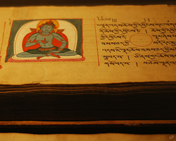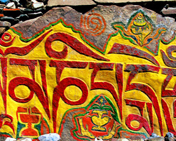Tibetan Language and Communication

Tibetan is spoken in Tibet, Bhutan, Nepal, and also in parts of northern India (including Sikkim). It is classified by linguists as a member of the Tibeto-Burman subgroup of the Sino-Tibetan languages. It is known as 'bod-yig' in the Tibetan-inhabited areas with the meaning of 'Tibetan language', which has its own system, in both spoken and written forms. Tibetan is written in a very conservative syllabify script based on the writing system of the ancient Sanskrit language of India. Tibetan language consists of thirty consonant, four vowels, five inverted letters (for the renting of foreign words) and the punctuations.

According to geographical divisions, it has three major local dialects: Weizang, Kang and Amdo. The first two dialects have their own tones in pronunciation while the latter don't. Sentences are written from right to the left. Tibetan language and customs are enjoying respect. And the outstanding heritage of Tibetan culture has been carried forward. The strict social caste system was manifested even in the use of language. The Tibetan language has three major forms of expression: the most respectful, the respectful and the everyday speech, to be used respectively to one's superiors, one's peers and one's inferiors. This introduction of Tibetan language may help you in setting up unforgettable relationship with Tibetan people.








 8 Days Nyingchi Shigatse Namtso Tour
8 Days Nyingchi Shigatse Namtso Tour  4-Day Lhasa Join-in Group Tour
4-Day Lhasa Join-in Group Tour  5 Days Lhasa Group Tour with Yamdrok Lake
5 Days Lhasa Group Tour with Yamdrok Lake  5 Days Lhasa Pilgrimage Tour to Ganden Monastery & Drak Yerpa
5 Days Lhasa Pilgrimage Tour to Ganden Monastery & Drak Yerpa  6 Days Lhasa Shigatse Group Tour
6 Days Lhasa Shigatse Group Tour  5 Days Lhasa-Namtso-Lhasa Group Tour
5 Days Lhasa-Namtso-Lhasa Group Tour  7 Days Overland Tour from Lhasa to Kathmandu
7 Days Overland Tour from Lhasa to Kathmandu  8 Days Lhasa-Shigatse-EBC-Group Tour
8 Days Lhasa-Shigatse-EBC-Group Tour  7 Days Central Tibet Group Tour with Namtso
7 Days Central Tibet Group Tour with Namtso  Data in submission...
Data in submission...


